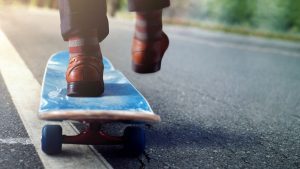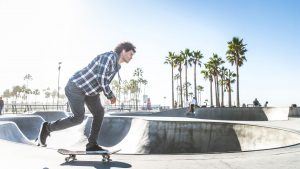Longboard Balancing
At FamilyHype, we understand the importance of balance when it comes to skateboarding. We’ve all been there – stepping onto a skateboard for the first time, wobbling uncontrollably, and taking a tumble.
It’s part of the skateboard learning process, but having the right balance tips is key to truly enjoying. Explore our balance tips and tricks! These tips can be your guide to enjoying your future ride.

This article will give you tips that will help you stay on skateboard and safely enjoy skateboarding. From understanding the basics of skateboarding, such as body positioning, foot placement, and stance, to strengthening your core, practicing to improve balance and techniques, ensuring safety measures are in place, practicing regularly, and learning from professionals – we’ll cover it all.
Skateboarding isn’t just about tricks and speed; it’s also about maintaining control while serving others with respect within the community. So strap on your helmet and kneepads because we’re about to embark on a journey toward improved balance and increased confidence in your skateboarding skills! Remember – every great skater started somewhere – let’s make sure you stay on skateboard with good equilibrium!
Key Takeaways
In this article you will learn some tips on how to stay balance on a skateboard. These tips will help you balance on skateboard! Understanding the skateboard balancing basics, strengthening your core muscles, and regularly skateboarding are essential components of learning how to stay balanced on a skateboard. Safety, patience, and determination are key values that you must possess and continually cultivate to master balance on a skateboard.
It’s important to remember that skateboarding is not just about skateboard tricks – it’s about resilience, determination, and confidence. So don’t forget to wear skateboard safety gear, practice regularly, and be patient.
Keep rolling, stay balanced, and let us know how your progress is going. With our essential advice and your determination, you’ll be able to stay balanced on your skateboard in no time!

Understanding The Basics
When it comes to skateboarding, balance is a fundamental skill that can make a significant difference in your performance and safety. One excellent way to work on your balance is by using a balancing skateboard. This simple tool allows you to engage your core muscles and build balance, making it perfect for beginner skateboarders and experienced skaters alike. By placing your back foot in a position on the stability skateboard and your left foot in a position on the skateboard, you can start practicing to find your stability.
For beginners, focusing on finding the right stability on the skateboard is crucial. Position your front foot at an angle, and if you’re feeling confident, try lifting the other foot off the ground and maintain stability on just one foot at an angle. It may be challenging at first, but with consistent practice, your balance will improve. Wearing good skate shoes also helps.
Skateboarding is an art that requires skill, practice, and the right equipment. The primary element of this article is skateboarding equipment, which includes skateboards, trucks, wheels, bearings, and grip tape. These components are essential in creating a skateboard that fits your style and needs.
It’s also important to understand the different skateboarding disciplines, such as street, park, vert, and longboarding. To master the art of skateboarding, the right equipment, along with the right technique and strength, is essential.
With these basics under your belt, you’re well on your way to becoming a skilled skateboarder!
Core Strength
A skateboarder’s core strength and conditioning regime should include a few key exercises. These exercises include planks, yoga poses, jumping jacks, squats, and single-leg stands. Incorporating these exercises into your routine will not only improve your stability but also provide the foundation to progress to more advanced skateboarding techniques.
Stability skateboards are not only great for beginners but also for experienced skaters looking to take their skills to the next level. Incorporate exercises on the stability skateboard into your regular routine to improve your balance further. The more you practice stabilizing, the better your overall skateboarding stability will be.
Having a good balance while doing this sport is essential for staying safe and preventing injuries. Always wear the right gear, including a helmet, wrist guards, and elbow pads, especially when trying new tricks or hitting the skate park. This protective gear can save you from potential injuries and build confidence in your skateboarding experience.
By incorporating these exercises into your routine, you’ll be able to enjoy the benefits of increased balance, flexibility, endurance, and leg power. So, if you want to take your skateboarding skills to the next level, consider incorporating these core workouts into your routine.

Balance Techniques
Yoga, Pilates, and other balance training equipment, such as shape balance skateboards or wobble cushions, can help you gain better balance and equilibrium. It’s also important to choose the correct footwear for maximum safety and performance.
To maintain balance on a skateboard, stay relaxed and keep a slight bend in your knees, distributing your body weight evenly over the skateboard. When riding on a flat surface, center your body weight to stay balanced and in control. For advanced skaters, finding a low center of gravity can make a big difference in balance, especially when performing tricks or moving skateboard at faster speeds.
As you continue to practice and improve balance, you’ll notice that muscle memory plays a significant role in your skateboarding skills. The more you engage in balancing exercises and practice on the skateboard, the more your body learns to adapt and maintain balance effortlessly.
Remember to pay attention to both feet during your skateboarding sessions. Your back foot is crucial for steering and controlling the skateboard, while your front foot plays a vital role in initiating tricks and sustaining balance. Mastering the coordination between both feet will enhance your overall skateboarding performance.
Skateboarding, as a sport, encompasses a variety of elements, from technique to safety. With the right improvement techniques, you can gain confidence and control which can lead to superior skateboarding skills.
So, why not give it a try and see the difference it can make?
Safety Measures
Safety should always be the top priority when you’re out there enjoying the thrill of skateboarding. Don’t forget that safety measures help protect you and your family from the best way harm’s way.
- Prioritizing safety is the top concern during sports activities.
- Protective gear, including helmets, is crucial for preventing severe injuries and showing respect for possible and future risks.
- Emphasis on safeguarding vulnerable body parts to boost confidence while safely pushing limits especially when trying different routines and tricks.
- Knowing the importance of regular practice with adherence to key safety precautions for all riders of this sport.
Practice Skateboard Regularly
We can’t stress enough the importance of practicing regularly when it comes to skateboarding. Consistency is key, as it helps us gradually build our skills and confidence on a skateboard.
Keeping tracking of our progress also plays a crucial role in understanding how far we’ve come and identifying areas where we need improvement; after all, we’re on this journey together for continuous learning and growth.
Importance Of Consistency
Consistency in your skateboarding practice isn’t just about hitting the pavement every day; it’s also about keeping gravity low, visualizing, and executing each move with precision like a graffiti artist carefully crafting his next masterpiece on a blank wall.
Consistency rewards us with progress, such as improved balance and control, muscle memory, and video confidence, and helps in overcoming plateaus.
Next, let’s delve into the significance of tracking this consistent growth. Skateboarding is a niche activity and an important part of the larger entity of extreme sports. Within this entity, there are a variety of specific activities, such as ramps, grinds, and kickflips, that all require consistent practice to master.
Tracking the progress of this consistent growth can help skaters see the improvements they have made and further motivate them to continue growing and learning new tricks. Additionally, tracking progress can give skaters a way to measure themselves against their peers and stay competitive.
So, if you’re looking to improve your skateboarding skills, consistency is key! With consistent practice, you’ll be able to build your confidence and progress your skills, allowing you to reach new heights in your journey.
Progress Tracking Strategies In Skateboarding: Importance
Having established the significance of consistency, let’s now turn our attention to progress tracking. By monitoring balance metrics such as speed, distance, and maneuverability over time, we can visualize your improvement in skateboarding and identify areas for further development.
This isn’t about competing with others; it’s about serving your personal growth and progress in the skateboarding world. With progress visualization, you’ll see how far you’ve come! We hope that our content will help you to learn, grow, and progress with your skills. Please don’t hesitate to reach out with any questions or feedback you might have.
Next, let’s dive into how engaging with professionals can elevate your balance skills even more. By connecting with those in the community, you can learn from experts who have years of experience in the sport. You can also benefit from their knowledge of the skating industry, which can help you to stay on top of the latest trends and techniques. With the right guidance, you can take your balance skills to the next level!
Learn From Professionals
Don’t underestimate the value of observing professional skateboarders; their refined techniques and tricks can provide a wealth of knowledge about maintaining balance on the skateboard.
Balance is at the core of this sport. Whether you’re a beginner or an experienced skater, using balance skateboards and practicing balancing exercises can greatly improve your skills. Don’t forget to wear the right protective gear and maintain a low center of gravity while doing this sport.
With dedication and consistent practice, you’ll discover more techniques to develop exceptional balance and elevate your abilities to new heights! So, hit the skateboard and embrace the thrill of riding with perfect balance!
Also, consider their pro gear selection. By understanding what skateboard decks, trucks, wheels, and bearings they use and why, we can better equip ourselves for success. With the right advice, we can reach our full potential as skateboarders and explore all the possibilities that skateboarding has to offer.
Conclusion
You have read the tips to help you improve your skateboarding balance. Understanding the basics, strengthening your core muscles, and regularly practicing are essential components of learning how to stay balanced on a skateboard. Additionally, please be sure to take safety measures and wear a helmet and knee pads. Learning to balance on your skateboard is a journey that requires patience, resilience, and determination. Skateboards offer a unique opportunity to challenge yourself and develop new skills – so don’t give up during the learning process!
FAQs
How Not To Wobble On A Board?
To avoid wobbling on a skateboard, start with the basics and practice coming to a complete stop completely. Practice keeping your weight evenly distributed between both feet and maintaining a stable stance. Focus on engaging your core muscles for stability. Avoid overreacting to small movements and make gradual adjustments to maintain stability.
How Do I Improve My Balance?
To improve balance, learn the basics. Practice standing on the balance skateboard with feet parallel and slightly shoulder-width apart. Gradually shift your weight from one foot to the other to get a feel for the skateboard’s stability. Take your time. Practice riding slowly, turning, and stopping, and gradually increase speed and confidence as you become more comfortable on the skateboard, especially at slower speeds. Experienced skaters also say that learning how to fall correctly is one of the best ways to build confidence and improve balance. Falling off your skateboard is a part of this sport.
How Do You Skateboard With Bad Balance?
If you struggle to balance on the board, start by placing one foot on the skateboard and the other on the ground while holding onto something stable for support, especially for beginner skaters. Find your center of gravity. Gradually shift your weight onto the skateboard foot and practice maintaining balance. Focus on core strength and stability exercises off the balance skateboard to improve balance. Also, figure out which foot placement you’re most comfortable with. Some prefer having their left foot in front, while others prefer the opposite.
How Do You Balance A Skateboard While Pushing?
To balance while pushing on flat ground, keep your weight centered over the skateboard and maintain a stable stance. Use short and controlled pushes with your foot to maintain balance and gradually increase speed as you become more confident. Keep your eyes forward and focus on a fixed point to help with stability.
How Do You Push On A Skateboard Without Losing Balance?
When pushing on a skateboard, ensure your feet are in a comfortable stance with the pushing foot slightly angled and pushing off the ground with more weight in a controlled manner. Keep your upper body stable and centered over the skateboard to maintain stability. Practice pushing in a straight line first, and as you gain confidence, incorporate turns and maneuvers while pushing.
Do Skateboards Improve Balance?
Yes, balance skateboards can improve balance and stability. Using a balance skateboard regularly challenges your body to maintain equilibrium, strengthening muscles and enhancing proprioception. This, in turn, can positively impact your stability on a skateboard and in other physical activities.
How Can I Make My Balance Board More Challenging?
To make a balance skateboard more challenging, try exercises on one leg or incorporate movements like squats or lunges while balancing. You can also increase the difficulty by adjusting the skateboard’s balance point to create a less stable surface.
Why Does My Board Feel So Wobbly?
A skateboard may feel wobbly due to various factors, such as loose trucks, uneven weight distribution, or worn-out bearings. Check that the trucks are tightened properly, distribute your weight evenly, and consider replacing any worn or damaged components.
How Do You Push Harder On A Board?
To push harder on a skateboard, focus on generating more force with each push using your foot. Use a full leg motion, extending your pushing leg fully to propel the balance skateboard forward with more power. Practice pushing drills to improve your technique and build strength.
How Do You Balance On A Board?
Balancing on a skateboard or balance skateboard involves keeping your body centered and stable over the skateboard. Engage your core muscles for better stability, and practice regularly to improve your proprioception and control. Focus on maintaining a relaxed but stable posture to find the optimal balance point.
Last Updated on June 10, 2024 by Shulammite Jan Languido
DISCLAIMER (IMPORTANT): This information (including all text, images, audio, or other formats on FamilyHype.com) is not intended to be a substitute for informed professional advice, diagnosis, endorsement or treatment. You should not take any action or avoid taking action without consulting a qualified professional. Always seek the advice of your physician or other qualified health provider with any questions about medical conditions. Do not disregard professional medical advice or delay seeking advice or treatment because of something you have read here a FamilyHype.com.